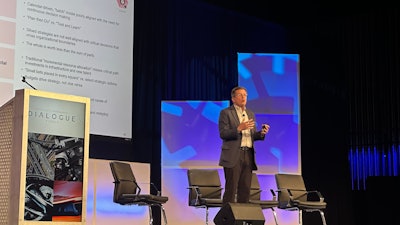
While many people may be ready for precedented times, that's unlikely to happen any time soon, as the sessions at the Heavy Duty Aftermarket Dialogue ahead of Heavy Duty Aftermarket Week 2024 in Dallas.
[RELATED: Mack's Randall says 2024 truck sales could exceed expectations]
"We are living in turbulent times," says Mark Gottfredson, advisory partner of Bain & Company, a global management consultancy. "When you're doing a forecast, really the only thing that you know, for sure, is that it's going to be wrong."
He highlighted the major variables that face the heavy duty industry, including battery electric vehicle adoption, availability and supply chain constraints; e-commerce and omnichannel sales; rise of insurgents with new value-added services; government regulation; innovation in alternative drivetrains; autonomous use and adoption; and transport as a service.
In dealing with all of this uncertainty, Gottfredson says, traditional decision-making processes don't work very well. Decisions come out with the wrong priority and in the wrong order. Interdependencies and linkages between decisions get ignored. Flexibility and other options are undervalued in decision-making.
"Decisions are made incorrectly, at the wrong pace or in the wrong order, foreclosing too many valuable, strategic options," Gottfredson says.
[RELATED: MEMA's 'Chasing the Aftermarket' showcases benefits of business intelligence tools]
Coping with turbulence requires two changes to the plan-then-do method of business: leadership must change the tools it applies to making strategic choices and they must change the process it uses to develop plans and allocate resources.
"Let me propose to you that there's a lot of value in a little bit different approach to scenario planning," Gottfredson says. "Consider extreme but plausible scenarios. Look for the extreme. Not what you believe will happen, but imagine a string of things that will happen to create an extreme outcome."
This allows for imagining how things come together and connect, he says, and that allows for flexibility in planning.
Businesses should also identify trigger points, signposts and metrics to track.
"We're trying to cast our headlights out so we can see a change before it happens," Gottfredson says. "We want to see it before our competition."
Those triggers, signposts and metrics can lead to three kinds of scenarios. Those are corner scenarios, which are extreme but plausible; reference scenarios, which are the ones management has the most confidence in; and plausible scenarios, alternatives to the reference scenario that management may not be as convinced will happen. Using those scenarios, organizations can then get three outcomes: No-regret moves, surface big bets and potential strategic options.
And all of those things are driven by decisions.
"To cope with unpredictability across the board, leadership must move from a static, strategic planning process to dynamic strategic management," Gottfredson says. "Instead of reporting the news, we should be deciding the future."
This creates a living strategic plan, fueled by meetings that look forward and have agendas that outline decisions to be made, not facts to report.
"What does 2024 look like? Well, I don't know," Gottfredson asked a room full of murmuring attendees discussing decision-based meetings. "The trajectory for your company has less to do with macroeconomics and more of what you decide to do with your company."
As an example, Gottfredson looked to Dell, the personal computer company. It took off in its earliest days, but by 2008-2009, the company had matured and performance began to stall. Stock prices dipped and the company sprawled across the technological spectrum. Dell made printers, servers, cameras, even a phone.
"They were trying to play in every part oof the technology stack that you could imagine," he says. As the company swelled, its ability to execute was hamstrung. Dell went private in order to make some strategic changes to spur growth again. It simplified it's product portfolio, cutting phones and jettisoning low-performing tech. It refocused management on decision-making.
"Every meeting is focused on decisions," Gottfredson says. "We don't have a meeting unless we need to make a decision. What decisions are we going to make today? People have to be prepared to make that decision."
In 2021, the new and improved Dell was sold for $84 billion.
"This was plain old blocking and tackling and making the business better in an industry that was actually shrinking," Gottfredson says.
Dell isn't alone, and uncertainty isn't just a tech sector problem. Uncertainty, if navigated correctly, can push organizations forward, no matter what the forecast says.
"Just about every sector of the economy is experiencing increases in volatility and uncertainty," he says. "That creates problems, but it also creates opportunity."









